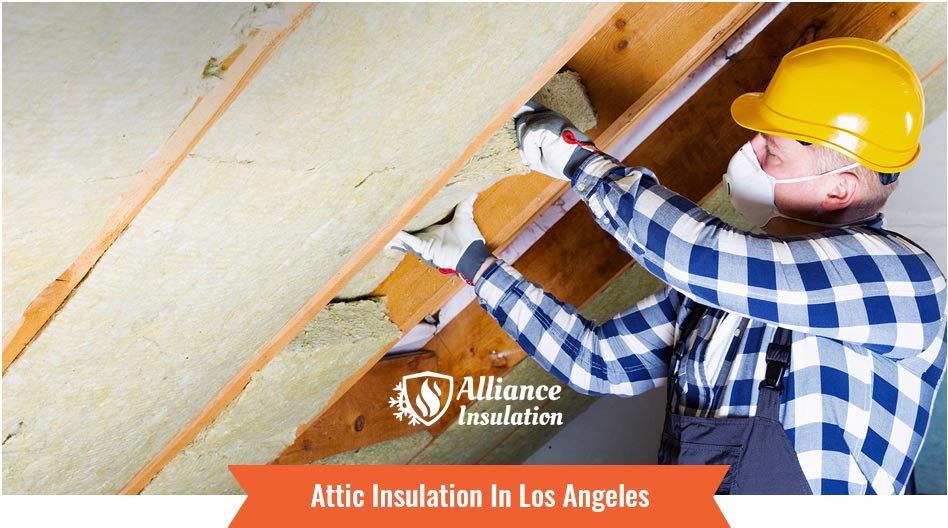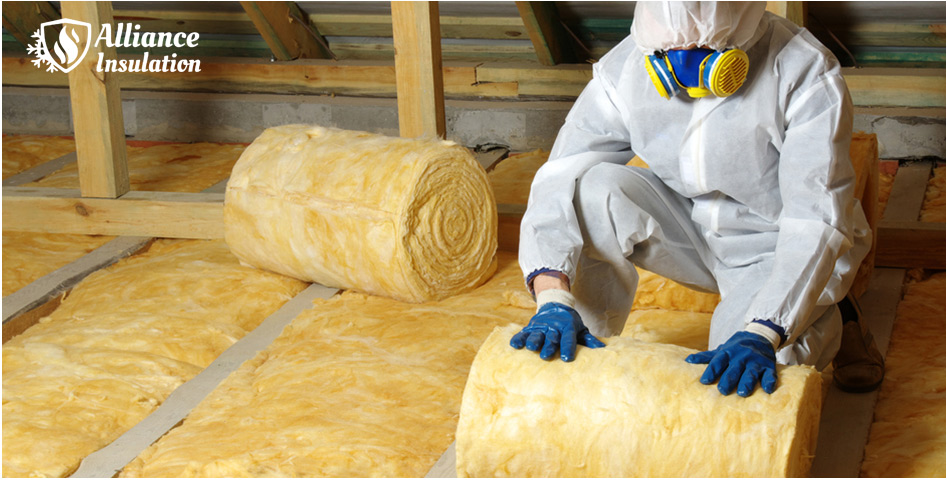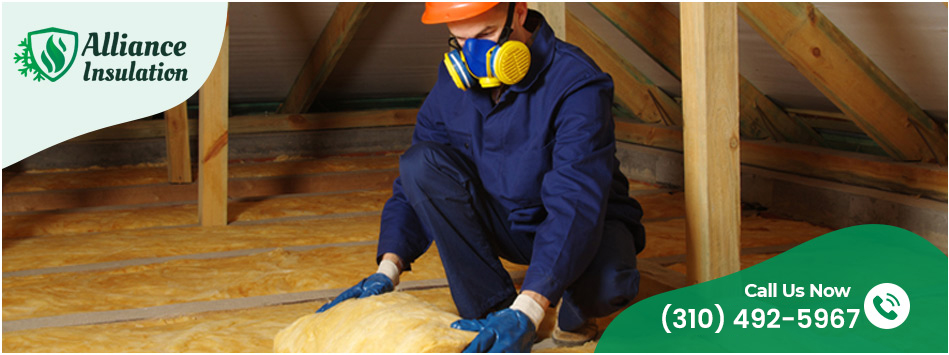
Attic insulation in Los Angeles
Attic insulation in Los Angeles provides homeowners with numerous benefits. Adequate insulation helps regulate indoor temperature, reduce energy consumption, and enhance overall comfort. In Los Angeles, where hot summers and mild winters are common, proper attic insulation becomes even more vital.
he different requirements for attic insulation in Los Angeles usually include meeting specific R-value standards set by local building codes. Hiring a professional contractor like Alliance Insulation is essential for ensuring proper installation and compliance with regulations. They have the expertise to assess insulation needs, recommend suitable materials, and install insulation effectively, maximizing energy efficiency and long-term cost savings for homeowners in Los Angeles.
The Four Core Elements of Insulation in Attic
When it comes to attic insulation in Los Angeles, you need to be aware of the core elements. The four core elements of attic insulation are
Insulation Material
The type of insulation material used in the attic is a fundamental element. Common options include fiberglass batts, cellulose, spray foam, or mineral wool. Each material has different properties in terms of insulation efficiency, moisture resistance, fire resistance, and environmental impact.
R-Value
The R-value measures the thermal resistance of insulation and determines its effectiveness in preventing heat transfer. It indicates how well the insulation material resists the flow of heat. The recommended R-value for attic insulation depends on factors such as climate, local building codes, and energy efficiency goals

Here’s a table with the different attic insulation materials and their corresponding R-Values ranges
| Insulation Material | R-Value Range (per inch) |
|---|---|
| Fiberglass (batts or rolls) | R-2.9 to R-3.8 |
| Cellulose (loose-fill) | R-3.1 to R-3.8 |
| Spray Foam (closed-cell) | R-6.0 to R-7.0 |
| Spray Foam (open-cell) | R-3.5 to R-4.5 |
| Mineral Wool (batts or rolls) | R-3.0 to R-4.0 |
| Expanded Polystyrene (EPS) | R-3.6 to R-4.2 |
| Extruded Polystyrene (XPS) | R-4.5 to R-5.0 |
| Polyisocyanurate (Polyiso) | R-5.6 to R-8.0 |
Vapor Barrier
A vapor barrier, also known as a moisture barrier, is a component that helps prevent moisture from entering the attic space. It is typically installed on the warm side of the insulation to prevent condensation and potential moisture damage. The use of a vapor barrier depends on the climate and local building requirements.
Installation
The quality of installation is crucial for attic insulation performance. Proper installation ensures that insulation is evenly distributed, without any gaps, voids, or compression. It also involves sealing air leaks, such as around electrical outlets, pipes, and attic access points, to enhance energy efficiency and prevent heat loss.
Our Services for Attic Insulation in Los Angeles
As a contractor specializing in attic insulation in Los Angeles, we offer a range of services to meet the specific insulation needs of homeowners. Here are some of the services that we offer
Insulation Installation
Get help in assessing the existing insulation levels and get recommendations for suitable insulation materials and techniques for the attic. Our team will handle the complete installation process, ensuring proper coverage, and achieving optimal insulation performance.
Insulation Removal
In cases where the existing insulation is damaged, outdated, or contaminated, you can get insulation removal services. Get assistance to safely remove the old insulation, dispose of it properly, and prepare the attic for new insulation installation.
Air Sealing
Identify and seal air leaks in the attic, including gaps around electrical wires, pipes, vents, and other potential sources of air leakage. Proper air sealing improves energy efficiency, prevents drafts, and enhances the overall effectiveness of attic insulation.
Attic Ventilation
Get a proper assessment of the attic ventilation system to ensure it is properly designed and functioning effectively. Our team will help you install or repair attic vents, soffit vents, ridge vents, or gable vents to promote adequate air circulation and prevent moisture buildup
Insulation Upgrades
If the existing attic insulation is inadequate or does not meet current energy efficiency standards, you can upgrade the insulation by adding additional layers or replacing it with more efficient insulation materials
Energy Audits
Get energy audit services to assess the overall energy efficiency of the home. Evaluate insulation levels, air leaks, HVAC systems, and other factors that impact energy consumption. This helps homeowners identify areas for improvement and make informed decisions about attic insulation upgrades
Insulation Maintenance
Get ongoing maintenance services for attic insulation, such as inspections, cleaning, or repairs, to ensure optimal performance and longevity.
Attic Insulation in Los Angeles – Rules & Regulations
In Los Angeles, attic insulation must adhere to certain rules and regulations to ensure compliance with energy efficiency standards and building codes. The specific rules and regulations that apply to attic insulation in Los Angeles include
Title 24 Energy Standards
Title 24 is the California Energy Efficiency Standards, which sets requirements for energy efficiency in buildings. It includes provisions for insulation levels, thermal performance, and air sealing in attics to minimize heat transfer and promote energy conservation
California Building Code, 2022
The California Building Code (CBC) provides guidelines and regulations for construction and renovation projects. It includes requirements for insulation materials, installation methods, fire safety, and other aspects related to attic insulation
Los Angeles Municipal Code
The Los Angeles Municipal Code has additional local requirements or amendments specific to the city. You need to ensure compliance with any specific regulations or permits required for attic insulation projects
Health and Safety Codes
Certain health and safety codes also apply to attic insulation, particularly regarding the handling and installation of insulation materials. These codes aim to ensure the safety and well-being of occupants and address potential hazards associated with insulation products
Choosing the Right Insulation Material
We offer complete assistance in helping you choose the right attic insulation material for your specific needs. Here’s how they can assist you
Assessment
Our team will assess your attic space, considering factors such as the current insulation, climate, building structure, and energy efficiency goals. They will evaluate your unique requirements to determine the most suitable insulation material
Knowledge and Expertise
We have extensive knowledge about different insulation materials, including their properties, benefits, and limitations. Know the characteristics of each material and how they align with your specific needs, ensuring you make an informed decision
Energy Efficiency Recommendations
Our team understands the energy efficiency standards and regulations in your area. Get recommendations on insulation materials that meet or exceed the required R-Value or energy efficiency requirements, helping you optimize energy savings and comply with local codes.
Cost Considerations
Get insights into the cost-effectiveness of various insulation materials. We can provide you with information about upfront costs, long-term savings, and return on investment, allowing you to make a decision that fits your budget and financial goals.
Performance and Durability
With our experience, we are familiar with the performance and durability of different insulation materials. Get the guidance you need in selecting materials that are known for their longevity, resistance to moisture, pests, and fire, ensuring your attic insulation remains effective over time.
Installation Expertise
We are skilled in the proper installation techniques for various insulation materials. We understand the nuances of each material and can ensure a seamless installation, maximizing its performance and minimizing any potential issues or gaps that could compromise insulation effectiveness.
Safety Precautions for Attic Insulation in Los Angeles
When our team is working on attic insulation, it is important to prioritize safety for both the workers and the occupants of the building. Here are some essential safety precautions to follow
Adequate Ventilation
Ensure that the attic space has sufficient ventilation to prevent the buildup of fumes, dust, or excessive heat. If necessary, use fans or open windows to improve air circulation during the insulation work.
Electrical Safety
Ensure that our team is aware of any electrical hazards in the attic, such as exposed wiring or live electrical connections. Advise them to take necessary precautions, such as turning off power sources or using insulated tools when working near electrical components.
Secure Footing and Fall Protection
Ensure that the team has a secure footing and proper fall protection measures in place, such as using safety harnesses or installing temporary guardrails when working on elevated surfaces or near openings.
Safe Material Handling
Follow the guidance on safe handling and lifting techniques for insulation materials to prevent strains, sprains, or other injuries. Ensure that heavy materials are properly lifted and moved using appropriate equipment.
Proper Lighting
Ensure that the attic space is adequately lit to allow contractors to work safely and effectively. Consider installing temporary lighting fixtures if the existing lighting is insufficient.
Clear Pathways and Obstacle Removal
Clear any clutter or obstacles from the attic space to provide a safe and unobstructed work area. Remove any tripping hazards, sharp objects, or debris that could cause accidents.
Regular Inspections
Conduct regular inspections of the attic work area to identify and address any safety concerns promptly. Monitor the progress of the insulation work and ensure that contractors are following safety protocols
Faq’s
In Los Angeles, the requirement for permits to install attic insulation can vary depending on the scope of the work and the specific regulations of the local building department. Generally, permits are not usually required for simple attic insulation projects that involve adding or replacing insulation material within the existing structure without any significant alterations.
Attic insulation generally does not have a specific lifespan. However, over time, insulation may settle, degrade, or become less effective. It’s a good idea to inspect your attic insulation periodically and replace or add insulation as needed. Factors such as damage, pest infestation, or changes in building codes may also necessitate insulation replacement.
The recommended amount of attic insulation is measured by its R-value. The R-value represents the insulation’s resistance to heat flow, with higher values indicating better insulation. The appropriate R-value for your attic depends on factors such as your climate zone. The U.S. Department of Energy provides guidelines and recommendations for R-values based on location.
Get a Free Quote


